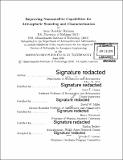Improving nanosatellite capabilities for atmospheric sounding and characterization
Author(s)
Marinan, Anne Dorothy
DownloadFull printable version (22.84Mb)
Other Contributors
Massachusetts Institute of Technology. Department of Aeronautics and Astronautics.
Advisor
Kerri L. Cahoy.
Terms of use
Metadata
Show full item recordAbstract
Measurements of atmospheric temperature, pressure, water vapor, and composition are important to users in the Earth science, defense, and intelligence communities. Nanosatellites (with mass < 10 kg, such as CubeSats) can support miniaturized instruments for atmospheric sounding and characterization. Nanosatellite constellations can improve spatial and temporal coverage of Earth and can produce data consistent with the current state of the art at reduced cost compared with larger satellites. Nanosatellites are also used for on-orbit technology demonstrations due to low cost and higher risk posture. We focus on CubeSats as a host platform for instruments and technology demonstrations for three kinds of atmospheric sensors: (i) passive microwave radiometers, (ii) atmospheric occultation experiments and (iii) coronagraphic direct imaging of exoplanets. Microwave radiometers (MWR) measure brightness temperatures in multiple channels across bands centered on atmospheric absorption features. MWRs require stable cold and warm calibration targets for accurate measurements. CubeSat MWRs, such as MicroMAS (the Micro-sized Microwave Atmospheric Satellite) and MiRaTA (Microwave Radiometer Technology Acceleration), use deep space as a cold target with a noise diode as the warm target instead of larger calibration targets. However, noise diodes drift, and a better calibration method is needed to meet the desired measurement precision. Occultation experiments measure electromagnetic signals received from a transmitter as it passes behind the Earth from the perspective of the receiver. In the neutral atmosphere, the measurements yield profiles of temperature, pressure and in certain configurations, composition. We consider radio and optical wavelengths. GPS Radio Occultation (GPSRO) instruments measure phase delay in signals transmitted from GPS satellites that travel through the atmosphere to a low earth orbit (LEO) receiver. GPSRO measurements are inherently well calibrated, because the primary interaction is of an electromagnetic wave through a medium, and have high accuracy and vertical resolution. We show that it is possible to make several GPSRO measurements per day that are collocated spatially and temporally with space-based MWR measurements and that using these measurements enables better MWR calibration by measuring noise diode drift. Occultation observations using several near infrared optical wavelengths can measure absorption features to characterize atmospheric species and abundances. Intersatellite optical links are used for these measurements, but transmissions deep in the atmosphere experience scintillation and distortion. Wavefront control systems could be used to compensate for atmosphere-induced aberrations. Wavefront control systems are also needed to obtain reflection absorption spectra of exoplanet atmospheres, where photons from the host star are reflected by the planet. A space-based telescope equipped with an internal coronagraph can make high contrast measurements off-axis using high spatial frequency wavefront control systems to correct for speckles, imperfections, and other distortions that would degrade the measurement. High actuator count deformable mirrors (DMs) are needed, and Microelectromechanical systems (MEMS) DMs can provide a cost-effective, compact solution. We describe our design for a nanosatellite platform using a wavefront sensor to characterize the on-orbit performance of MEMS DMs. We present results from these new approaches to improve atmospheric sounding and characterization missions using nanosatellites. Our hardware analysis for MiRaTA demonstrates that the CubeSat GPSRO instrument noise performance supports the calibration of the noise diode to improve the CubeSat MWR measurement accuracy from > 0.75 K to 0.25 K. We simulate and experimentally demonstrate a CubeSat wavefront control system using a MEMS DM that can be used to characterize the performance of MEMS DMs, sensitive to 10's of nm motion and up to three times the 1.5 pm-stroke of the DMs, which is useful for future applications in both atmospheric near infrared occultation as well as in exoplanet direct imaging space telescopes. Each of these contributions improves current nanosatellite capabilities or uses nanosatellites to advance technologies in future larger systems for atmospheric sounding and characterization of Earth and exoplanets.
Description
Thesis: Ph. D., Massachusetts Institute of Technology, Department of Aeronautics and Astronautics, 2016. Cataloged from PDF version of thesis. Includes bibliographical references (pages 207-218).
Date issued
2016Department
Massachusetts Institute of Technology. Department of Aeronautics and AstronauticsPublisher
Massachusetts Institute of Technology
Keywords
Aeronautics and Astronautics.